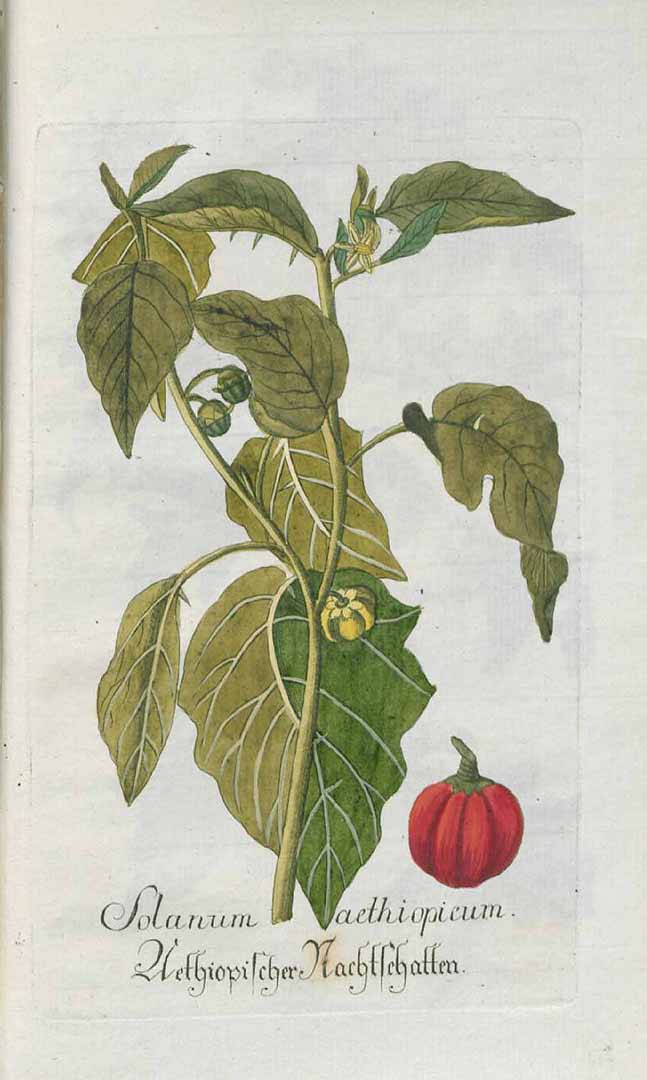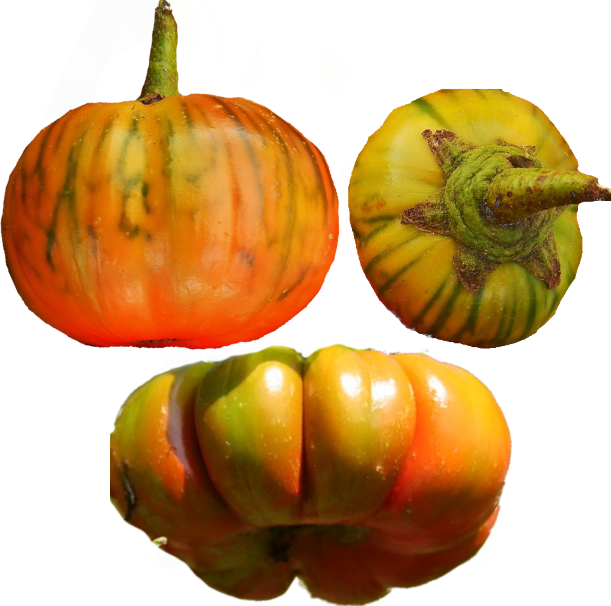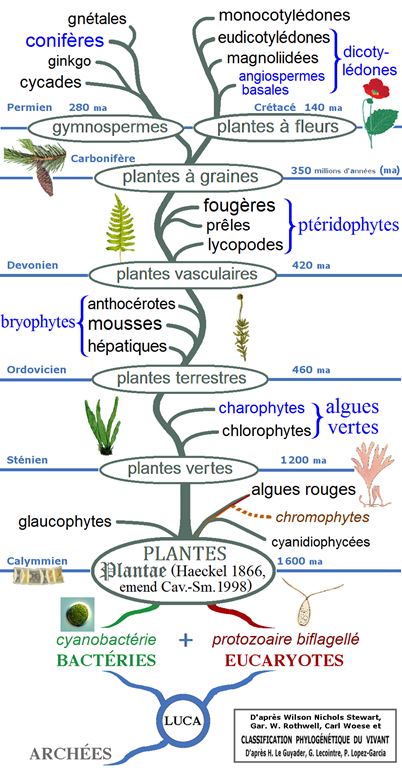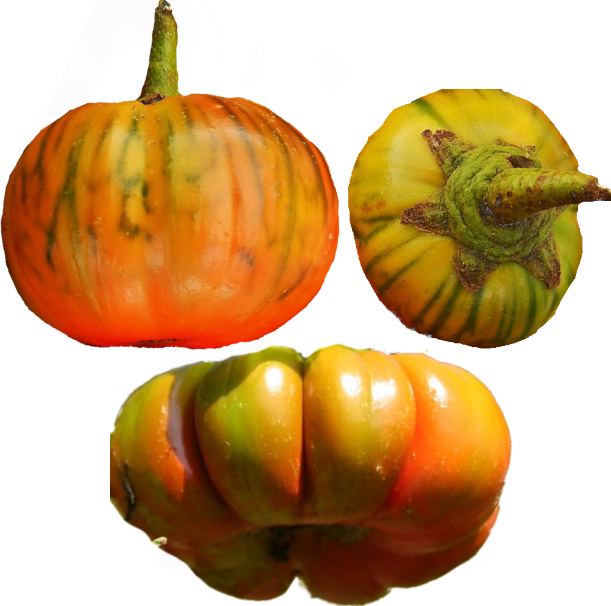Aubergine africaine
(Solanum aethiopicum)

-2/0°C
Une herbe ou un arbuste. Il atteint 1 à 2 m de haut. Il peut croître de 2 à plusieurs années. Les feuilles ont des lobes peu profonds. Il y a 2 à 6 fleurs. Les fruits son ... (traduction automatique)
→suite
Aubergine africaine 


Note alimentaire ![]()
![]()
Une herbe ou un arbuste. Il atteint 1 à 2 m de haut. Il peut croître de 2 à plusieurs années. Les feuilles ont des lobes peu profonds. Il y a 2 à 6 fleurs. Les fruits sont gros, de forme ronde et inégale. Ils sont rouge orangé. La forme des fruits peut varier. Il existe 3 sous-groupes principaux. L'un est princi... (traduction automatique) →suite
Classification
- Classique : en haut de l\'écran, sous le coeur.
- Phylogénétique :
- Clade 4 : Angiospermes ;
- Clade 3 : Dicotylédones_vraies ;
- Clade 2 : Astéridées ;
- Clade 1 : Lamiidées ;
- Ordre APN : Solanales ;
- Famille APN : Solanaceae ;
Illustration : cet arbre phylogénétique des plantes montre les principaux clades et groupes traditionnels (monophylétiques en noir et paraphylétiques en bleu).
Dénominations
✖- Nom botanique : Solanum aethiopicum L. (1759)
- Synonymes français : aubergine amère, aubergine éthiopienne, olombé du Gabon [var. pierreanum], aubergine écarlate, petite bringelle maronne (Afrique), tomate amère
- Synonymes : Solanum gilo Raddi 1820, Solanum gilo var. pierreanum (Pailleux & Bois) Bitter 1923 (synonyme, selon GRIN ; nom irrésolu et sous-espèce distincte différente, selon TPL), Solanum integrifolium Poir. 1797, Solanum pierreanum Pailleux & Bois 1890 (synonyme, selon GRIN ; synonyme de "Solanum gilo var. pierreanum (Pailleux & Bois) Bitter", selon TPL) ;
- Noms anglais et locaux : Chinese scarlet eggplant, gilo, kumba, scarlet eggplant, shum, tomato-fruit eggplant , African bitter pea-aubergine, African eggplant, bitter tomato, Ethiopian eggplant, garden egg, Jamaican bitter balls, wild pea-aubergine, wild African aubergine, jilo (pt,br), röd aubergin (sv)
Description et culture
✖Nombre de graines au gramme :
300
- dont infos de "FOOD PLANTS INTERNATIONAL" :
Description :
Une herbe ou un arbuste. Il atteint 1 à 2 m de haut. Il peut croître de 2 à plusieurs années. Les feuilles ont des lobes peu profonds. Il y a 2 à 6 fleurs. Les fruits sont gros, de forme ronde et inégale. Ils sont rouge orangé. La forme des fruits peut varier. Il existe 3 sous-groupes principaux. L'un est principalement destiné aux fruits et l'autre aux feuilles{{{0(+x) (traduction automatique).
Original : A herb or shrub. It grows 1-2 m tall. It can grow from 2 to several years. The leaves have shallow lobes. There are 2-6 flowers. The fruit are large, round and uneven shape. They are orange-red. Fruit shape can vary. There are 3 main sub groups. One is mainly for fruit and the other is mainly for leaves{{{0(+x).
Production :
Les rendements de fruits peuvent être de 40 t / hectar{{{0(+x) (traduction automatique).
Original : Yields of fruit can be 40 t / hectare{{{0(+x).
Culture :
Les plantes sont cultivées à partir de graines. Les graines sont récoltées à partir de fruits bien mûrs. Ils sont lavés puis séchés sur papier. Ils peuvent être stockés dans un récipient sec et frais à l'abri de la lumière du soleil. Les graines peuvent être semées dans des caisses de pépinière et transplantées. Un espacement d'environ 1 m convient. Les semis sont transplantés après 30 à 35 jours. Les plantes n'ont pas besoin de tuteur{{{0(+x) (traduction automatique).
Original : Plants are grown from seeds. Seeds are collected from fully ripe fruit. They are washed and then dried on paper. They can be stored in a dry cool container out of the sunlight. Seeds can be sown in nursery boxes and transplanted. A spacing of about 1 m is suitable. Seedlings are transplanted after 30-35 days. Plants do not need staking{{{0(+x).
 Consommation (rapports de comestibilité, parties utilisables et usages alimentaires correspondants)
Consommation (rapports de comestibilité, parties utilisables et usages alimentaires correspondants)
✖
Partie(s) comestible(s){{{0(+x) : feuilles, fruit, légume{{{0(+x)µ.
Utilisation(s)/usage(s)µ{{{0(+x) culinaires :
-les fruits sont cuits et mangés ; ils sont également utilisés pour aromatiser d'autres produits alimentaires ; ils peuvent être picklés ;
-les jeunes pousses ou les bourgeons de fleurs sont tranchés finement coupés pour une utilisation dans les soupes{{{~~0(+x) ; jeunes pousses également cuites (ex. : comme potherbe) ? (qp*).
Partie testée :
feuilles crues{{{0(+x) (traduction automatique). Original : Leaves raw{{{0(+x)| Taux d'humidité | Énergie (kj) | Énergie (kcal) | Protéines (g) |
|---|---|---|---|
| 82.1 | 213 | 51 | 4.8 |
| Pro- vitamines A (µg) |
Vitamines C (mg) | Fer (mg) | Zinc (mg) |
| / | / | 8.0 | / |
 Risques et précautions à prendre
Risques et précautions à prendre
✖
ATTENTION : même si aucune mention spécifique de la toxicité n'a été vu pour cette espèce, il appartient à un genre où beaucoup sinon tous les membres ont des feuilles toxiques et parfois aussi les fruits immatures{{{5(+).
Galerie(s)
✖Autres infos
✖dont infos de "FOOD PLANTS INTERNATIONAL" :
Statut :
C'est un légume cultivé commercialement. C'est l'un des légumes les plus répandus en Afrique tropicale. Il est exporté vers l'Europe. Il est cultivé commercialement au Brésil{{{0(+x) (traduction automatique).
Original : It is a commercially cultivated vegetable. It is one of the most common vegetables in tropical Africa. It is exported to Europe. It is grown commercially in Brazil{{{0(+x).
Distribution :
C'est une plante subtropicale. Il peut pousser dans des endroits arides. Il pousse dans la savane. En Chine, il pousse entre 400 et 1 800 m d'altitude{{{0(+x) (traduction automatique).
Original : It is a subtropical plant. It can grow in arid places. It grows in the savannah. In China it grows between 400-1,800 m above sea level{{{0(+x).
Localisation :
Afrique, Angola, Asie, Australie, Bénin, Botswana, Brésil, Burkina Faso, Burundi, Cameroun, Cap-Vert, Caraïbes, Afrique centrale, République centrafricaine, RCA, Tchad, Chine, Comores, RD Congo, Congo R, Côte d'Ivoire, Djibouti, Afrique de l'Est, Égypte, Guinée équatoriale, Érythrée, Éthiopie, Europe, France, Gabon, Gambie, Ghana, Guinée, Guinée, Guinée-Bissau, Inde, Italie, Côte d'Ivoire, Japon, Kenya, Libéria , Madagascar, Malawi, Mali, Mauritanie, Maurice, Mozambique, Namibie, Niger, Nigéria, Afrique du Nord, Rwanda, Sao Tomé-et-Principe, Sénégal, Sierra Leone, Afrique australe, Amérique du Sud *, Soudan, Tanzanie, Togo, Ouganda, Ouest Afrique *, Zambie, Zimbabwe{{{0(+x) (traduction automatique).
Original : Africa, Angola, Asia, Australia, Benin, Botswana, Brazil, Burkina Faso, Burundi, Cameroon, Cape Verde, Caribbean, Central Africa, Central African Republic, CAR, Chad, China, Comoros, Congo DR, Congo R, Côte d'Ivoire, Djibouti, East Africa, Egypt, Equatorial Guinea, Eritrea, Ethiopia, Europe, France, Gabon, Gambia, Ghana, Guinea, Guinée, Guinea-Bissau, India, Italy, Ivory Coast, Japan, Kenya, Liberia, Madagascar, Malawi, Mali, Mauritania, Mauritius, Mozambique, Namibia, Niger, Nigeria, North Africa, Rwanda, Sao Tome and Principe, Senegal, Sierra Leone, Southern Africa, South America*, Sudan, Tanzania, Togo, Uganda, West Africa*, Zambia, Zimbabwe{{{0(+x).
Notes :
Il existe environ 1400 espèces de Solanum{{{0(+x) (traduction automatique).
Original : There are about 1400 Solanum species{{{0(+x).
Rusticité (résistance face au froid/gel, climat)
✖-2/0°C
Échanges/Dons
✖Semeurs.free
Liens, sources et/ou références
✖Sources et/ou références :
5"Plants For A Future" (en anglais) ;
dont classification : "The Plant List" (en anglais) ; "GRIN" (en anglais) ;
dont livres et bases de données : 0"Food Plants International" (en anglais), 76Le Potager d'un curieux - histoire, culture et usages de 250 plantes comestibles peu connues ou inconnues (livre, pages 442 à 444 [Solanum pierreanum Pailleux & Bois], par A. Paillieux et D. Bois) ;
Le potager d'un curieux - histoire, culture et usages de 250 plantes comestibles, peu connues ou inconnue (par Auguste Pailleux et Désiré Bois, 3ème édition de 1899) / détails du livre ; Semences de Kokopelli (de Dominique Guillet, 6ème édition, 2007) / détails du livre
dont biographie/références de "FOOD PLANTS INTERNATIONAL" :
Abbiw, D.K., 1990, Useful Plants of Ghana. West African uses of wild and cultivated plants. Intermediate Technology Publications and the Royal Botanic Gardens, Kew. p 35 Amoen. acad. 4:307. 1759 Achigan-Dako, E, et al (Eds), 2009, Catalogue of Traditional Vegetables in Benin. International Foundation for Science. Bodkin, F., 1991, Encyclopedia Botanica. Cornstalk publishing, p 934 (As Solanum integrifolium) Burkill, H. M., 1985, The useful plants of west tropical Africa, Vol. 5. Kew. Busson, 1965, Dalziel, J. M., 1937, The Useful plants of west tropical Africa. Crown Agents for the Colonies London. Dibong, S. D., et al, 2011, Inventory and Biodiversity of species edible wild fruits sold in the markets of Douala, Cameroon. International Journal of Applied Biology and Pharmaceutical Technology. 2(3). Epenhuijsen C.W. van., 1974, Growing Native vegetables in Nigeria. FAO Rome, p 80 Epenhuijsen C.W. van., 1974, Growing Native vegetables in Nigeria. FAO Rome, p 82 (As Solanum gilo) Facciola, S., 1998, Cornucopia 2: a Source Book of Edible Plants. Kampong Publications, p 236 FAO, 1988, Traditional Food Plants, FAO Food and Nutrition Paper 42. FAO Rome p 450, 453 Flora Zambesiaca. https://apps.kew.org/efloras Food Composition Tables for use in Africa FAO https://www.fao.org/infoods/directory No. 715, 716 Fowler, D. G., 2007, Zambian Plants: Their Vernacular Names and Uses. Kew. p 61 Gbile, Z. O. and Adesina, S. K., 1988, Nigerian Solanum Species of Economic Importance. Annals of the Missouri Botanical Garden, Vol. 75, No. 3. p 862 Goode, P., 1989, Edible Plants of Uganda. FAO p 26 Grivetti, L. E., 1980, Agricultural development: present and potential role of edible wild plants. Part 2: Sub-Saharan Africa, Report to the Department of State Agency for International Development. p 30 Grubben, G. J. H. and Denton, O. A. (eds), 2004, Plant Resources of Tropical Africa 2. Vegetables. PROTA, Wageningen, Netherlands. p 472 Hedrick, U.P., 1919, (Ed.), Sturtevant's edible plants of the world. p 613 Hedrick, U.P., 1919, (Ed.), Sturtevant's edible plants of the world. p 614 (As Solanum gilo) Hibbert, M., 2002, The Aussie Plant Finder 2002, Florilegium. p 291 INFOODSUpdatedFGU-list.xls Jardin, C., 1970, List of Foods Used In Africa, FAO Nutrition Information Document Series No 2.p 101 Jardin, C., 1970, List of Foods Used In Africa, FAO Nutrition Information Document Series No 2.p 102 (As Solanum gilo var. pierreanum) Kays, S. J., and Dias, J. C. S., 1995, Common Names of Commercially Cultivated Vegetables of the World in 15 languages. Economic Botany, Vol. 49, No. 2, pp. 115-152 Liengola, I. B., 2001, A contribution to the study of native edible plants by the Turumbu and Lokele of the Tshopo District, Province Orientale, D. R. Congo. Syst. Geogr. Pl. 71:687-698 Martin, F.W. & Ruberte, R.M., 1979, Edible Leaves of the Tropics. Antillian College Press, Mayaguez, Puerto Rico. p 76, 220 Mertz, O., Lykke, A. M., and Reenberg, A., 2001, Importance and Seasonality of Vegetable Consumption and Marketing in Burkina Faso. Economic Botany, 55(2):276-289 Molla, A., Ethiopian Plant Names. https://www.ethiopic.com/aplants.htm Nkeoua, G. & Boundzanga, G. C., 1999, Donnees sur les produits forestieres non ligneux en Republique du Congo. FAO. p 37 Okigbo, B.N., Vegetables in Tropical Africa, in Opena, R.T. & Kyomo, M.L., 1990, Vegetable Research and development in SADCC countries. Asian Vegetable Research and development Centre. Taiwan. p 45 Okigbo, B.N., Vegetables in Tropical Africa, in Opena, R.T. & Kyomo, M.L., 1990, Vegetable Research and development in SADCC countries. Asian Vegetable Research and development Centre. Taiwan. p 45 (As Solanum gilo) Oomen, H.A.P.C., & Grubben, G.J.H., 1978, Tropical Leaf Vegetables in Human Nutrition, Communication 69, Department of Agricultural research, RTI Amsterdam, p 83 Peters, C. R., O'Brien, E. M., and Drummond, R.B., 1992, Edible Wild plants of Sub-saharan Africa. Kew. p 186 Plants For A Future database, The Field, Penpol, Lostwithiel, Cornwall, PL22 0NG, UK. https://www.scs.leeds.ac.uk/pfaf/ Royal Botanic Gardens, Kew (1999). Survey of Economic Plants for Arid and Semi-Arid Lands (SEPASAL) database. Published on the Internet; https://www.rbgkew.org.uk/ceb/sepasal/internet [Accessed 11th June 2011] Smith, F. I. and Eyzaquirre, P., 2007, African leafy vegetables: Their role in the World Health Organization's global Fruit and Vegetables Initiative. AJFAND, Vol. 7 No. 3 Strangeland, T et al, 2009, Total antioxidant activity in 35 Ugandan fruits and vegetables. Food Chemistry 113: 85-91 Termote, C., et al, 2011, Eating from the wild: Turumbu, Mbole and Bali traditional knowledge of non-cultivated edible plants, District Tshopo, DRCongo, Gen Resourc Crop Evol. 58:585-618 Terra, G.J.A., 1973, Tropical Vegetables. Communication 54e Royal Tropical Institute, Amsterdam, p 76 (As Solanum gilo) Terra, G.J.A., 1973, Tropical Vegetables. Communication 54e Royal Tropical Institute, Amsterdam, p 73 Tindall, H.D., & Williams, J.T., 1977, Tropical Vegetables and their Genetic Resources, International Board for Plant Genetic Resources, Rome, p 106 USDA, ARS, National Genetic Resources Program. Germplasm Resources Information Network - (GRIN). [Online Database] National Germplasm Resources Laboratory, Beltsville, Maryland. Available: www.ars-grin.gov/cgi-bin/npgs/html/econ.pl (10 April 2000) Van Epenhuijsen, Zon, A.P.M. van der, Grubben, G.J.H., 1976, Les legumes-feuilles spontanes et cultives du Sud-Dahomey, Communication 65, Royal Tropical Institute, Amsterdam, p 90 Weinberger, K., Msuya J., 2004, Indigenous Vegetables in Tanzania. Significance and Prospects. Technical Bulletin No. 31 AVRDC, Taiwan/FAO
Recherche de/pour :
- "Solanum aethiopicum" sur Google (pages et
images) ;
TROPICOS (en anglais) ;
Tela Botanica ;
Pl@ntNet ;
Pl@ntUse ;
- "Aubergine africaine" sur Google (pages, images et recettes) ;
- "Solanum aethiopicum" sur Google (pages et
images) ;
TROPICOS (en anglais) ;
Tela Botanica ;
Pl@ntNet ;
Pl@ntUse ;
Sous-espèces, variétes...
✖39 taxons
- Aubergine africaine
- Solanum aethiopicum
- Solanum aethiopicum
- Solanum aethiopicum
- Solanum aethiopicum
- Aubergine africaine cv. 'Brazilian Mini Orange'
- Aubergine africaine cv. 'Brazilian Orange Oval'
- Aubergine africaine cv. 'Comprido Cachoeira'
- Aubergine africaine cv. 'Comprido Grande Rio'
- Aubergine africaine cv. 'Comprido Verde Claro'
- Aubergine africaine cv. 'Diakhatou'
- Aubergine africaine cv. 'Dwomo'
- Aubergine africaine cv. 'Gilo'
- Aubergine africaine cv. 'Goyo Kumba'
- Aubergine africaine cv. 'Jaxatu Soxna'
- Aubergine africaine cv. 'Keur M'Bir N'Dao'
- Aubergine africaine cv. 'Manyire Green'
- Aubergine africaine cv. 'Melanzana Rossa Di Rotonda'
- Aubergine africaine cv. 'Morro Grande Verde-Escuro'
- Aubergine africaine cv. 'Morro Redondo'
- Aubergine africaine cv. 'N'Drowa'
- Aubergine africaine cv. 'N'Drowa Issia'
- Aubergine africaine cv. 'N'Galam'
- Aubergine africaine cv. 'N'Goyo'
- Aubergine africaine cv. 'Português'
- Aubergine africaine cv. 'Red China'
- Aubergine africaine cv. 'Red Egg'
- Aubergine africaine cv. 'Red Ruffled'
- Aubergine africaine cv. 'Red Skin'
- Aubergine africaine cv. 'Striped Nigerian'
- Aubergine africaine cv. 'Striped Toga'
- Aubergine africaine cv. 'Super N"Drowa'
- Aubergine africaine cv. 'Sweet African Egg'
- Aubergine africaine cv. 'Sweet Red'
- Aubergine africaine cv. 'Tengeru White'
- Aubergine africaine cv. 'Tinguá'
- Aubergine africaine cv. 'Turkish Orange'
- Aubergine africaine (f. small ruffled red)
- Aubergine africaine (f. sodefel)
Espèces du même genre (Solanum)
✖50 taxons (sur 319)
- Solanum abutiloides (Griseb.) Bitter & Lillo (Mini tamarillo)
- Solanum acaule Bitter (Pomme de terre sauvage des Andes)
- Solanum acroglossum Juz. (Pomme de terre sauvage)
- Solanum aculeastrum
- Solanum aculeatissimum Jacq.
- Solanum acuminatum
- Solanum aethiopicum L. (Aubergine africaine)
- Solanum aethiopicum L. (Gilo Group) x Solanum anguivi Lam. (Damsah)
- Solanum agrarium
- Solanum ajanhuiri Juz. et Bukasov (Pomme de terre amère)
- Solanum albicans (Ochoa) Ochoa (Pomme de terre sauvage)
- Solanum albornozii Correll (Pomme de terre sauvage)
- Solanum album
- Solanum aloysiifolium
- Solanum alternatopinnatum
- Solanum amayanum Ochoa (Pomme de terre sauvage)
- Solanum ambrosiacum
- Solanum americanum Mill. (Morelle d'amérique ou américaine)
- Solanum amygdalifolium
- Solanum andigenum
- Solanum anguivi Lam. (Uganda pea)
- Solanum anomalum
- Solanum anthropophagorum
- Solanum aridum
- Solanum asperum
- Solanum atropurpureum
- Solanum aviculare G.Forst. (Morelle des Oiseaux)
- Solanum ayacuchense Ochoa (Pomme de terre sauvage)
- Solanum bansoense
- Solanum baquicha (Baquicha)
- Solanum barbeyanum
- Solanum barbisetum
- Solanum basendopogon
- Solanum beniense
- Solanum berthaultii Hawkes (Pomme de terre sauvage)
- Solanum betaceum Cav. (Tamarillo)
- Solanum blumei
- Solanum boerhaaviifolium
- Solanum boliviense Dunal (Pomme de terre sauvage)
- Solanum bonariense L.
- Solanum boreale
- Solanum boyacense
- Solanum brevicaule Bitter (Pomme de terre sauvage)
- Solanum brevifolium
- Solanum bulbocastanum Dunal (Pomme de terre sauvage)
- Solanum burbankii Bitter (Wonderberry)
- Solanum cajamarquense Ochoa (Pomme de terre sauvage)
- Solanum cajanumense Kunth (Casana)
- Solanum calidum
- Solanum candidum
- ...
Espèces de la même famille (Solanaceae)
✖50 taxons (sur 563)
- Atropa acuminata
- Atropa belladonna L. (Belladone)
- Brachistus solanaceus
- Brunfelsia chocoensis
- Brunfelsia macrocarpa
- Calliphysalis carpenteri
- Capsicum annuum L. (Piment)
- Capsicum annuum x chinense (Piment de neyde)
- Capsicum baccatum L. (Aji)
- Capsicum buforum Hunz.
- Capsicum caatingae Barboza & Agra
- Capsicum caballeroi M. Nee
- Capsicum campylopodium Sendtn.
- Capsicum cardenasii Heiser & P.G.Sm.
- Capsicum cardenasii x pubescens
- Capsicum ceratocalyx M.Nee
- Capsicum chacoense Hunz.
- Capsicum chinense Jacq. (Piment habanero)
- Capsicum chinense x frutescens (Naga jolokia)
- Capsicum coccineum (Rusby) Hunz.
- Capsicum conoides Mill.
- Capsicum cornutum (Hiern) Hunz.
- Capsicum dimorphum (Miers) O.K.
- Capsicum dusenii Bitter
- Capsicum eshbaughii
- Capsicum eshbaugii Barboza
- Capsicum exile (Cobincho)
- Capsicum eximium Hunz. (Bolivian bird pepper)
- Capsicum flexuosum Sendtn.
- Capsicum friburgense Barboza & Bianchetti
- Capsicum frutescens L. (Piment)
- Capsicum frutescens x eximium
- Capsicum galapagoense Hunz. (Piment des îles galapagos)
- Capsicum geminifolium (Dammer) Hunz.
- Capsicum grandiflorum Kuntze
- Capsicum havanense Kunth
- Capsicum hispidum Dunal
- Capsicum hookerianum (Miers) O.K.
- Capsicum hunzikerianum Barboza & Bianchetti
- Capsicum lanceolatum (Greenm.) C.V.Morton & Standl.
- Capsicum leptopodum (Dunal) Kuntze
- Capsicum longidentatum Agra & Barboza
- Capsicum lycianthoides Bitter
- Capsicum melongena
- Capsicum minutiflorum (Rusby) Hunz.
- Capsicum mirabile Mart ex. Sendt
- Capsicum mositicum Toledo ex Handro
- Capsicum parvifolium Sendt.
- Capsicum pereirae Barboza & Bianch.
- Capsicum praetermissum
- ...




